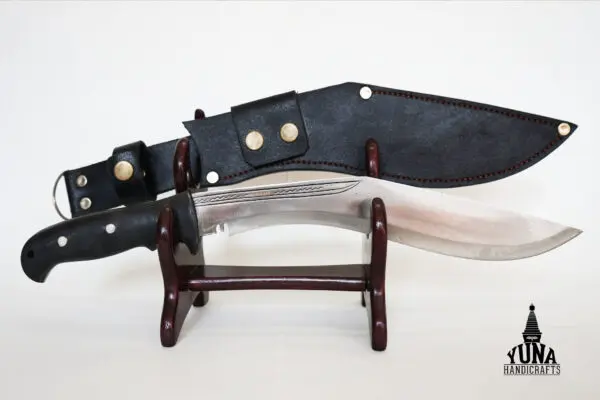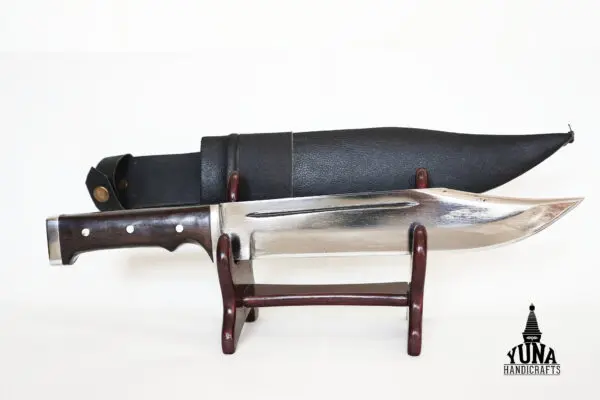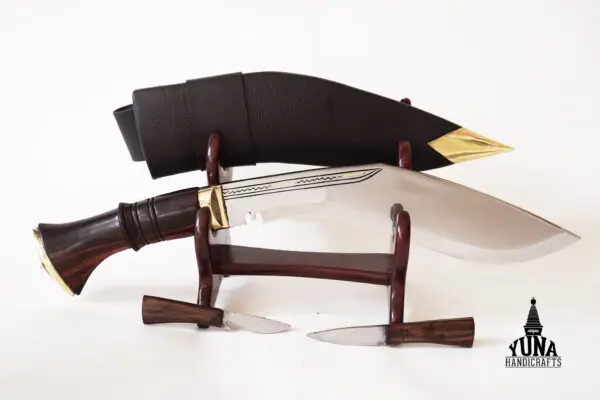Blog
Fixed Blade Khukuri
![]()
Table of Contents
Fixed Blade Khukuri
Intro: Fixed Blade Khukuri
Fixed Blade Khukuri: The Khukuri, also known as Kukri, is a distinct knife originating from Nepal and is most famously associated with the Gurkha soldiers. At Yuna Handicrafts, the fixed blade Khukuri stands as a proud emblem of Nepalese heritage, reflecting both cultural significance and practical functionality. As a fixed-blade knife, the Khukuri offers unparalleled strength, durability, and versatility, making it an ideal tool for collectors, outdoor enthusiasts, and admirers of Nepalese craftsmanship. This guide covers the full scope of the fixed blade Khukuri, including its history, unique design, uses, materials, and maintenance. We’ll explore why this legendary knife remains a celebrated piece in the world of edged tools and collectibles.

Historical Background of the Fixed Blade Khukuri
The Khukuri has a long-standing history dating back to ancient Nepal. It is believed to have originated with the Kirati people over a thousand years ago and later became a symbol of strength and bravery among the Gurkhas. Known for its curved design, the Khukuri has been used in combat and ceremonial occasions, solidifying its role in Nepalese culture. During British colonial rule, the Khukuri gained international recognition when Gurkha soldiers, armed with their iconic knives, served in various battles. Today, the Khukuri is a beloved cultural icon, deeply revered within Nepal and admired globally.
Design and Features of the Fixed Blade Khukuri
The fixed blade Khukuri’s design is one of its most distinguishing features. The knife’s unique shape, thickness, and balance make it stand out among other edged tools. A traditional Khukuri has a distinct recurve blade, which enhances its cutting and chopping efficiency. The inward curve of the blade helps focus force at the point of impact, making it effective for a wide range of tasks, from chopping wood to self-defense.
Blade Shape and Dimensions
A typical Khukuri blade measures between 10 to 12 inches, though larger or smaller versions exist depending on intended use. The inward curve of the blade allows for a deeper cut with minimal effort, and the thick spine provides stability and weight, giving the knife a strong chopping ability. The tip of the blade is often broader and thicker, allowing for a powerful impact, while the curved design ensures that the blade can handle both heavy-duty and precision tasks.
Handle Design and Grip
The handle of a Khukuri is ergonomically designed to provide a firm and comfortable grip. Traditional Khukuri handles are crafted from materials like hardwood, buffalo horn, or even metal. The handle shape tapers toward the end, allowing for a secure hold even during intense use. Some Khukuris feature a metal bolster or butt cap, which reinforces the handle and prevents slipping. The ergonomic handle design ensures that the Khukuri is easy to control, providing a balanced feel that enhances its functionality in various situations.
Practical Uses of the Fixed Blade Khukuri
The fixed blade Khukuri is an incredibly versatile tool, used for a variety of practical tasks. Originally used in battle, the Khukuri is now primarily a utility tool with applications in camping, survival, and even home use.

Outdoor and Survival Tool
Due to its strong build and design, the Khukuri is highly effective in outdoor settings. The knife’s curved blade makes it ideal for chopping wood, clearing brush, and cutting through thick vegetation, which is why it’s popular among campers and hikers. The Khukuri’s thick spine and balanced weight allow it to function as both a machete and a hatchet, making it a valuable tool for survival situations. In emergencies, the Khukuri can be used to cut ropes, build shelter, and even process food, showcasing its adaptability.
Self-Defense and Combat
Though the Khukuri’s primary use today is as a utility knife, it retains its reputation as a formidable weapon. The blade’s shape and weight make it effective for close combat, providing a powerful impact that few other knives can match. The Khukuri’s historical role in combat has made it a symbol of protection and bravery. Many collectors appreciate the Khukuri not only for its practical uses but also for its legacy as a combat tool.
Ceremonial and Symbolic Use
In Nepalese culture, the Khukuri holds symbolic value and is often used in ceremonial practices. It is common for Nepalese families to own a Khukuri, as it represents protection and strength. During certain festivals and rituals, the Khukuri is used in animal sacrifices as an offering to deities. The knife is also a popular choice for gifting, symbolizing good fortune and respect.
Materials Used in the Fixed Blade Khukuri
The materials used in crafting a Khukuri play a significant role in its quality, durability, and aesthetic appeal. At Yuna Handicrafts, each Khukuri is made with premium materials, following traditional techniques to ensure authenticity and functionality.
Blade Material
The blade of a Khukuri is typically made from high-carbon steel or stainless steel. High-carbon steel is preferred for its durability and sharpness retention, which makes it suitable for heavy-duty tasks. However, it requires regular maintenance to prevent rust. Stainless steel is another option, offering rust resistance and lower maintenance needs, though it may not hold an edge as well as high-carbon steel. Both materials are heat-treated to achieve the ideal hardness, ensuring that the Khukuri can handle demanding tasks without chipping or breaking.
Handle Material
Traditional Khukuri handles are crafted from natural materials like rosewood, buffalo horn, or even bone. These materials provide a comfortable grip and add to the aesthetic appeal of the knife. Wood handles are popular for their warmth and comfort, while buffalo horn offers a more resilient and moisture-resistant option. Each material is carefully selected to ensure durability and comfort, making the Khukuri easy to handle even in challenging conditions.
Sheath or Scabbard
The sheath of a Khukuri, often made from leather-covered wood, is designed to protect the blade and allow for safe carrying. Some sheaths come with additional tools, such as the Karda and Chakmak – smaller knives included with many Khukuris. The Karda is a utility knife, while the Chakmak is used for sharpening the Khukuri. This three-piece set enhances the Khukuri’s functionality, making it a comprehensive tool for various tasks.
Also visit:-
Types of Fixed Blade Khukuri
At Yuna Handicrafts, we offer a variety of fixed blade Khukuris, each with unique characteristics to suit different needs and preferences.
Service No. 1 Khukuri
This is a standard-issue Khukuri used by the Gurkha soldiers. It is known for its sturdy build and balanced design, making it suitable for both utility and combat. The Service No. 1 Khukuri is often made with a high-carbon steel blade and a hardwood handle, providing both strength and reliability.
Chainpure Khukuri
The Chainpure Khukuri is a traditional style known for its distinct shape and decorative elements. This Khukuri is often crafted with intricate carvings on the handle and blade, making it a popular choice among collectors. The Chainpure Khukuri is ideal for ceremonial use and as a display piece, though it retains full functionality.
Bhojpure Khukuri
Named after the Bhojpur region in Nepal, this Khukuri features a longer and thicker blade, making it effective for heavy-duty tasks. The Bhojpure Khukuri is favored by farmers and outdoorsmen for its ability to handle large chopping tasks. Its robust design makes it a practical choice for those looking for a multipurpose tool.

Maintenance and Care for Fixed Blade Khukuri
Proper maintenance is essential to preserve the longevity and functionality of a Khukuri. Regular care will ensure that the knife remains sharp, rust-free, and in optimal condition.
Also visit:-
Cleaning and Oiling the Blade
High-carbon steel Khukuris require regular cleaning and oiling to prevent rust. After each use, wipe down the blade with a soft cloth and apply a thin layer of oil. Mineral oil is a good choice as it provides a protective coating without causing any adverse reactions to the steel.
Sharpening the Blade
The Khukuri’s unique curved blade requires a specific technique for sharpening. It’s recommended to use a sharpening stone and maintain the blade’s angle while sharpening. The Chakmak tool included with many Khukuris can also be used to hone the edge between sharpenings.
Storing the Khukuri
When not in use, store the Khukuri in its sheath in a dry place to prevent moisture buildup. Avoid exposing the knife to extreme temperatures, as this can cause the handle material to expand or contract.
Choosing the Right Fixed Blade Khukuri at Yuna Handicrafts
Selecting the right Khukuri depends on individual preferences, intended use, and budget. At Yuna Handicrafts, we offer a wide selection of fixed blade Khukuris to suit different needs, from collectors’ pieces to functional outdoor tools. Each Khukuri is handcrafted with attention to detail, ensuring a high level of quality and authenticity.
Consider the Blade Size
Blade size is an important factor when choosing a Khukuri. Larger blades are suitable for heavy-duty tasks like chopping, while smaller blades offer better control for precision tasks. Assess your needs before choosing the blade size that fits your purpose.
Material and Craftsmanship
High-quality materials and craftsmanship are essential for a durable Khukuri. At Yuna Handicrafts, we prioritize traditional techniques and premium materials to ensure that each Khukuri meets our standards of quality and performance.
Aesthetic and Symbolic Appeal
For collectors, the aesthetic appeal and symbolic significance of a Khukuri may be a deciding factor. Traditional designs with decorative handles and intricate carvings are ideal for display purposes, while simpler designs offer practicality for everyday use.
Also visit:-
Conclusion: The Legacy of the Fixed Blade Khukuri
The fixed blade Khukuri is more than just a knife; it’s a piece of Nepalese history and culture. At Yuna Handicrafts, we take pride in offering authentic, handcrafted Khukuris that reflect this heritage. Whether you’re a collector, an outdoor enthusiast, or simply interested in owning a piece of Nepalese culture, our fixed blade Khukuris offer a unique combination of functionality, durability, and beauty. With proper care and maintenance, a Khukuri from Yuna Handicrafts is sure to be a treasured tool and keepsake for years to come.
FAQs on Fixed Blade Khukuri for Yuna Handicrafts:
- What is a fixed blade Khukuri? A fixed blade Khukuri is a traditional Nepalese knife with a curved blade, permanently fixed to its handle, known for its durability and strength.
- What makes the Khukuri unique? The Khukuri’s iconic inward curve enhances its chopping efficiency and power, making it distinct from other knives. Its design reflects centuries of Nepalese craftsmanship and culture.
- What is the history of the Khukuri? The Khukuri has a deep history in Nepal, used traditionally by Gurkha soldiers and as a utility tool in Nepalese communities for over a thousand years.
- Why is a fixed blade Khukuri better than a folding knife? A fixed blade Khukuri is generally stronger and more reliable than a folding knife, especially for heavy-duty tasks like chopping and cutting.
- What types of fixed blade Khukuris are available at Yuna Handicrafts? Yuna Handicrafts offers various types of Khukuris, including Service No. 1, Chainpure, and Bhojpure Khukuris, each designed for different purposes and preferences.
- What is the Khukuri blade made of? Typically, Khukuri blades are crafted from high-carbon or stainless steel, providing strength and durability suitable for various tasks.
- Are Khukuris handmade at Yuna Handicrafts? Yes, each Khukuri at Yuna Handicrafts is handcrafted by skilled artisans, preserving traditional Nepalese methods and craftsmanship.
- What is the handle of the Khukuri made from? Khukuri handles are often made from materials like hardwood, buffalo horn, or rosewood, each offering a comfortable and sturdy grip.
- What is the best way to maintain a Khukuri blade? To maintain a Khukuri blade, regularly clean and oil it to prevent rust. Sharpen it as needed and store it in a dry place.
- Can I use a Khukuri for camping and outdoor tasks? Yes, the Khukuri is an excellent tool for outdoor activities, ideal for tasks like chopping wood, clearing brush, and other camping needs.
- How sharp is a Khukuri blade? A Khukuri is designed to be very sharp, especially along its curved edge, which allows for effective slicing and chopping.
- Is a Khukuri a weapon or a tool? Historically, it served both roles. Today, it is primarily a tool but is also appreciated for its historical and symbolic significance.
- What is the difference between high-carbon and stainless steel Khukuris? High-carbon steel blades are known for durability and edge retention but need regular maintenance. Stainless steel blades resist rust but may require more frequent sharpening.
- What size Khukuri should I choose? It depends on your needs: larger Khukuris are better for heavy-duty tasks, while smaller ones are ideal for precision work and ease of carrying.
- Do Khukuris come with a sheath? Yes, most Khukuris from Yuna Handicrafts come with a traditional leather-covered wooden sheath to protect the blade.
- What are Karda and Chakmak? Karda and Chakmak are small tools that come with some Khukuris. Karda is a utility knife, while Chakmak is used to sharpen the Khukuri blade.
- Are Khukuris used in Nepalese rituals? Yes, the Khukuri is often used in religious and ceremonial rituals in Nepal, symbolizing protection and strength.
- Is a Khukuri easy to sharpen? Yes, though it requires proper technique due to the blade’s curved shape. Many Khukuris come with a Chakmak to aid in sharpening.
- Can I collect Khukuris even if I don’t plan to use them? Absolutely! Khukuris are popular among collectors due to their cultural significance, craftsmanship, and historical value.
- What is the average weight of a Khukuri? Depending on the size and type, Khukuris can weigh between 500 grams to 1 kilogram, with larger ones weighing more for heavy-duty tasks.
- What is the purpose of the notch near the handle? The notch, called “cho” or “kaudi,” serves as a symbolic mark, traditionally believed to catch blood and prevent it from reaching the handle.
- Is the Khukuri easy to handle? Yes, Khukuris are designed with ergonomic handles, allowing for a comfortable grip and better control.
- How do I store my Khukuri safely? Keep it in its sheath and store it in a cool, dry place away from moisture and extreme temperatures.
- What does the Khukuri symbolize? The Khukuri symbolizes courage, protection, and Nepalese heritage, often associated with the valor of the Gurkha soldiers.
- Why should I buy a Khukuri from Yuna Handicrafts? Yuna Handicrafts offers authentic, handcrafted Khukuris made by skilled Nepalese artisans, ensuring quality, tradition, and durability.
- How durable is a Khukuri from Yuna Handicrafts? Our Khukuris are crafted from high-quality materials and made to withstand extensive use, making them highly durable.
- Can I use a Khukuri for kitchen tasks? While possible, a Khukuri is better suited for outdoor and heavy-duty tasks. For kitchen use, a smaller, lighter knife may be more practical.
- Do Khukuris rust easily? High-carbon steel Khukuris can rust if not maintained properly. Regular cleaning and oiling are recommended for long-lasting durability.
- Are Khukuris legal to own? Yes, Khukuris are legal in most places, but it’s essential to check local laws if carrying it outside or traveling internationally.
- What makes a Khukuri from Yuna Handicrafts unique? Yuna Handicrafts offers Khukuris that are crafted with care, honoring traditional methods and using quality materials, making each knife unique and valuable.
Contact Us:-
ADDRESS
Loktantrik Chowk, Nakhipot-14, Lalitpur, Nepal
CONTACT HOURS
Sunday to Saturday 24/7
E-MAIL yuna.handicrafts@gmail.com
PHONE +977 9851-131344 (WhatsApp)


